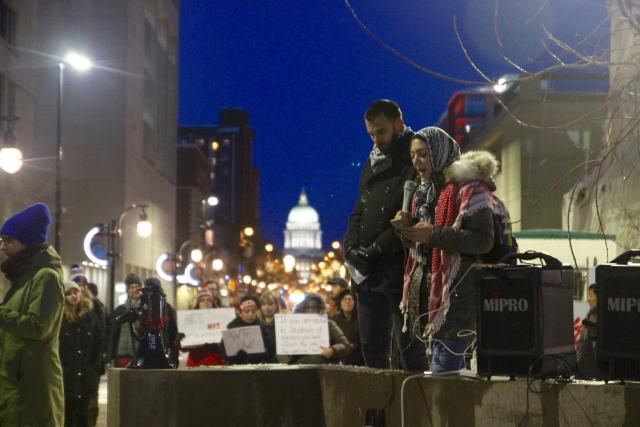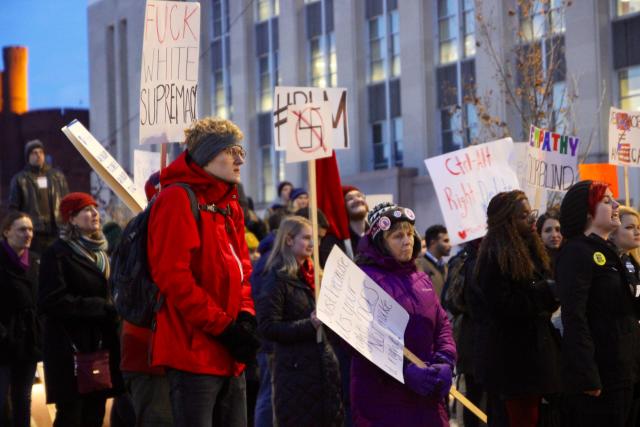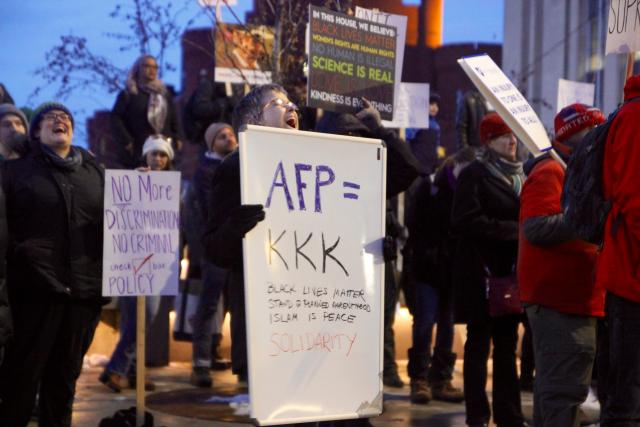






 Amal Ayesh, representing Students for Justice in Palestine, discussed her experience with racism, both in America and in her home country, as a Palestinian Muslim woman. (Melissa Behling/Madison Commons)
Amal Ayesh, representing Students for Justice in Palestine, discussed her experience with racism, both in America and in her home country, as a Palestinian Muslim woman. (Melissa Behling/Madison Commons)
Given the large number of executive actions President Donald Trump has taken in the first two weeks in office, Chief Mike Koval said he is mindful of the fact that there are “tipping points… for issues that are so compelling.”
“I would not be surprised to see forces mobilizing to register their dismay… given the sort of controversial nature of what the president has been doing,” Koval said.
Recently, one such demonstration took place. Protesters at Library Mall spoke out on Tuesday against the Alt-Right organizers attempting to open a chapter at the University of Wisconsin – Madison.
“Alt-Right” is a term coined by white nationalists whose core belief, according to the Southern Poverty Law Center, “is that ‘white identity’ is under attack by multicultural forces.”
In other words, it is what Katy Culver, Associate Professor in the School of Journalism and Mass Communication calls “shiny, glossy branding for really unbelievably dangerous ideas.”
Against the backdrop of the Capitol and motioning to the university administrators on Bascom Hill, speakers condemned Chancellor Rebecca Blank’s proposed solution to the problem. (Student media has covered this ongoing controversy. To learn more about the controversy, check out Badger Herald coverage.)
The group has since dropped the petition, but a question still lingers as protests and difficult issues in Trump era dealt with on campus might reverberate with the greater Madison community.
Problem for the community
The proposal for a white supremacy campus chapter came at a time when hate speech and hate crimes are of increasing concern. After the election of Trump, the Southern Poverty Law Center saw an increase in hateful harassment. Now entering the third week under Trump’s administration, his unfiltered comments on Twitter and in person have changed the national dialogue.
“It has become more acceptable to engage in [hate] speech, but it’s not as if those veins of hatred were not out there before,” Culver said.
Chief Mike Koval said activity like this would, by default, put the university on the Madison Police radar, knowing that “that will be a likely magnet of various contentiousness.”
 Protesters displayed signs opposing white supremacy and Naziism. (Melissa Behling/Madison Commons)
Protesters displayed signs opposing white supremacy and Naziism. (Melissa Behling/Madison Commons)
“If it is widely known that this is a gathering place for people who have very hateful rhetoric and/or philosophical views, that will at some point manifest a flashpoint for police presence because perhaps there will be counter-demonstrators,” Koval said.
Culver also said that a campus group could have greater impacts on the Madison community.
“I think that an Alt-Right student group on campus should be of concern not just to this campus, but to the community that surrounds it, to the state, to the nation,” Culver said. “To the extent that white supremacists have decided to rebrand themselves, put on khaki pants and start looking professional – we should all be concerned about that.”
Ali Brooks is an activist with Dane County’s Groundwork: White Anti-Racism Collective and joined the campus protest. Brooks said racist undertones on campus have always existed on institutional and interpersonal levels. But in her time on campus dating back 13 years, it has not manifested in an overt tone like this before.
“This kind of overt white supremacy has been kind of in the shadows, and it’s been emboldened by Trump, his rhetoric and the ‘Alt-Right’ coming more into the mainstream and grasping power in office through Steve Bannon,” Brooks said.
Students also understand this issue as more than just a campus issue.
Tyriek Mack is an undergraduate student at UW–Madison and a representative for the Associated Students of Madison. Speaking at the protest last Tuesday, Mack called the university an “elite bubble” within a city that struggles with poverty and some of the worst racial disparities in the country.
“We have to figure out a way to bridge the community with the university so that we as students can play our part in showing that this whole community gets better,” Mack said.
He said students need to understand the larger systemic issue, in particular, highlighting the city of Madison’s educational disparities.
“In order for us to fight white supremacy at this school, we’re going to have to start fighting in ways that don’t just necessarily affect us as students here but that affect the broader community of Madison,” Mack said.
“This is not up for debate.”
A college or university is meant to be a space for ideas to be shared and debates to be had. Ideally it is a place where students feel safe to engage openly in discussion. But that is not always the case.
“Sometimes ‘open’ and ‘safe’ are contradictory because people have different perceptions of what is safe,” Culver said.
Brooks said some speech should not be tolerated at all. “Allowing space for ‘Alt-Right’ organizing and white supremacist organizing to flourish or even have space and be legitimized as a valid view point worthy of debate is dangerous for our entire community,” Brooks said. “So wherever we see that, we to address it and shut it down.”
Several protesters on Tuesday shared this viewpoint and said white supremacist speech should not be allowed at UW–Madison.
Culver, however, prefers to have these ideas out in the open.
“I consider myself grateful to know that this is out there – that we know we have far further to go than I thought we did,” Culver said. She believes it’s important to recognize the amount of work to be done to educate people that ideologies like white nationalism are unacceptable.
This also brings into question the founding philosophies of First Amendment rights.
One idea is that even speech that is repulsive should be protected. In a democratic society, police officers must protect the freedom of speech and assembly for everyone.
“Even as much as that philosophical notion (white supremacy) is abhorrent to most reasonable people, the fact of the matter remains that if you claim to be constitutionally neutral...it would be preemptive for the police in this matter to decide who does or doesn’t get a street or parade permit,” Chief Koval said.
Second is the “steam valve” concept in free expression theory. “[Hate speech] allows people to express what I deem to be noxious thoughts, but in that expression it helps in not turning it into action,” Culver said. “When you shut down speech, when you drive it underground, people are more likely to act.”
Culver recognized what protesters were feeling, given that the student attempting to bring white supremacist ideals to campus has already acted and served jail time for hate crimes.
“I think any protester who wants to shut down that speech should think about what orthodoxy is like when you’re on the other side of it,” she said. “One of the reasons that we protect speech we hate is because at some point, we could need that protection for ourselves when we’re the ones who are not allowed to speak.”
Instead of suppressing speech, Culver said students should counter-argue it and focus on educating people.
Brooks also emphasized the importance of education.
“We need to engage people in realizing the value of multiculturalism and be able to bring people to the side of embracing multiculturalism and away from white supremacy in order to drown out those voices,” Brooks said.
At the protest, Brooks called white people to take a stand, explaining that “white silence is violence.”
 A protester from the Madison community laughs at a speaker’s joke. (Melissa Behling/Madison Commons)
A protester from the Madison community laughs at a speaker’s joke. (Melissa Behling/Madison Commons)
“I really feel that it is white people’s role in speaking up to white supremacy,” Brooks said. “Because for one, we have different stakes in the struggle – our bodies are not on the line. For people of color and people who are directly under attack by white supremacy and the ‘Alt-Right,’ it is dangerous to stand up to it.”
Brooks advocated for white people to root out white supremacy and to establish a “mass base of white people who are fighting for racial justice.”
Protests likely to continue
Koval said the Madison Police operate under a “crowd management” model to work with protesters and marchers rather than taking a “crowd control” method that would be adversarial. Their policies are outlined in the Madison Method.
Operating in Madison where political change is made, Koval said the Madison Police have a lot of opportunities to practice managing large crowds. He said if the first two weeks of Trump’s presidency are any indication, there will be more demonstrations.
“I think that this local government has taken it as a badge of honor that when you’re the heart of the state’s state capital, this is in fact a gathering place where people who want to express themselves are going to,” Koval said.
|
|
|
Welcome to the Madison Commons, a website designed to provide news and information about all of Madison's neighborhoods and a crossroads for the discussion of community issues. The name comes from the idea of a village commons, a place for news, talk, debate, and some entertainment, too, that's open to everyone.
All rights reserved. Read more about the Madison Commons and its partners.

